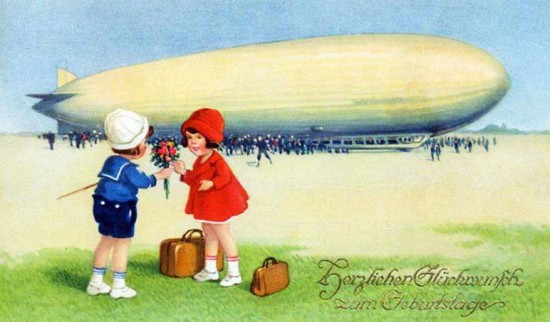
The world’s first zeppelin flew for the first time 115 years ago today, on July 2, 1900.
Count Ferdinand von Zeppelin completed his first airship, LZ-1, in the winter of 1899 but decided to wait until the summer of 1900 before attempting to fly his new invention. The ship was inflated with hydrogen in June and made its maiden flight on July 2, 1900. The first flight lasted about 18 minutes and covered about 3-1/2 miles over the Bodensee (Lake Constance) at Manzell (near Friedrichshafen) in Southern Germany, not far from the Swiss border.
LZ-1 (Luftschiff Zeppelin 1) was 420 feet long, 38-1/2 feet in diameter, and contained approximately 399,000 cubic feet of hydrogen in 17 gas cells made of rubberized cotton fabric. Two metal gondolas were suspended below the ship (one forward and one aft) and each gondola housed a 4-cylinder water-cooled Daimler gasoline engine producing about 14 horsepower. Each engine was connected by long shafts to two outrigger propellers mounted on either side of the hull. Pitch was controlled by a sliding weight suspended under the hull which could be shifted fore and aft; there were no elevators for pitch control, or fins for stability.
The first flight of LZ-1 was the culmination of years of planning by Count Zeppelin, but as a first attempt the ship had understandable weaknesses: LZ-1 was overweight, and a severe lack of engine power and speed made it difficult to control in even slight winds; the engines themselves were unreliable, and one failed during the short maiden flight; the ship suffered from poor controllability due to its lack of horizontal or vertical stabilizing fins and control surfaces, and the sliding weight system jammed, eliminating pitch control; and most importantly, the structure itself lacked rigidity due to its weak tubular frame, which hogged during flight, with its center portion rising high above its drooping bow and stern.
Attempts were made to increase the rigidity of the framework and address the other problems, and two additional flights were made, but the flights did not impress the military representatives in attendance that Zeppelin’s project deserved public funds, and Count Zeppelin was out of money. Zeppelin was forced to dismantle LZ-1.
But while LZ-1 itself was not a success, Count von Zeppelin’s basic concept was sound — a rigid metal frame containing individual gas cells covered by fabric — and formed the basis for all future zeppelin airships.
Zeppelin airships are still flying over the Bodensee today.
Happy Birthday, Zeppelins!







Very nice post.
And very good analysis of the fact.
Congrats, Dan!